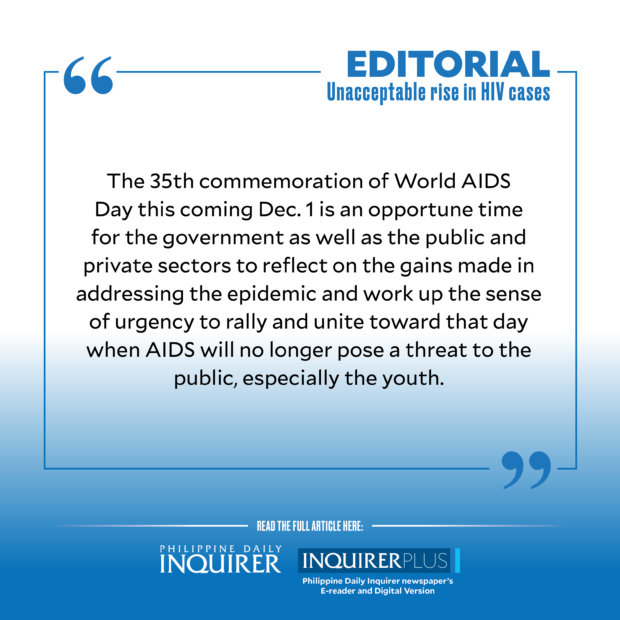
Alarm bells had long been sounded about the unabated increase in the number of Filipinos infected with the human immunodeficiency virus (HIV) that causes the potentially fatal acquired immunodeficiency syndrome (AIDS).
But the dire warnings have apparently fallen on deaf ears, thus dimming chances that the Philippines will meet the United Nations goal of ending the AIDS epidemic as a public health threat by 2030.
Indeed, instead of declining like in most parts of the world, the incidence of HIV- and AIDS-related deaths in the Philippines went in the opposite direction.
According to the Joint United Nations Programme on HIV/AIDS (UNAIDS), the Philippines posted the fastest growing HIV case in Asia-Pacific with a 237-percent increase in annual new HIV infections from 2010-2020. At the same time, AIDS-related deaths increased by 315 percent.
Indeed, if the hot pace holds, the number of people living with HIV in the country could reach 364,000 by 2030, which is a two-fold increase from estimated 158,400 PLHIV in 2022.
Even more frightening is the fact that the number of daily cases almost doubled in the past year alone, from 22 to 50, of which close to half or 47 percent involved young Filipinos aged 15 to 24, Health Secretary Teodoro Herbosa said last week.
Last March, the Department of Health (DOH) reported that 79 of the new 1,454 HIV cases recorded in January were aged 10-19 years old, and as many as seven were children below 9 years old.
The overall spike in cases can be attributed to the presence of a more infectious subvariant of the virus, but there are other more deep-seated factors at play. These include the notable lack of awareness among young Filipinos about the great risks posed by unprotected or unsafe sex, which has been identified globally as the most common cause of HIV, and dangerous misconceptions about how HIV can be contracted, leading to “dangerous” sexual behaviors.
The University of the Philippines Population Institute revealed last year that as cases rose, youth awareness of HIV/AIDS had dropped to its lowest level since 1994, based on the 2021 Young Adult Fertility and Sexuality Study, with only 76 percent of Filipinos aged 15-24 saying they have heard of HIV and/or AIDS, a 19-percentage point drop from the 1994 level of 95 percent.
Plus, more than half or 52 percent of the surveyed youth had the mistaken notion that a person can acquire HIV just by sharing food with an infected individual. Then about two in five did not believe that somebody who looked healthy can have HIV and a high 35 percent of the youth did not believe that using a condom during sex can reduce the risk of getting infected.
That awareness of HIV/AIDS has dropped so low and many young Filipinos still hold such misguided notions about HIV and AIDS more 40 years since these were first studied is clearly unacceptable.
This should therefore galvanize both the DOH and the Department of Education into embarking on an effective information campaign to improve knowledge on how HIV is contracted and thus rein in the runaway numbers.
Herbosa did say that he had already shared his concerns about the rise in HIV cases with Vice President and concurrent Education Secretary Sara Duterte, specifically on “interventions” to take to improve health literacy.
These must include the rigorous implementation of the Comprehensive Sexuality Education policy guidelines issued by former secretary Leonor Briones in 2018, prompted by concerns over the increase in the proportion of youth aged 15-24 who had early sexual encounters from 23 percent in 2002 to 32 percent in 2013 and findings that from January 1984 to February 2018, 28 percent of HIV cases involved this demographic involved in “risky sexual and social behaviors.”
Under the guidelines, the public school system should integrate comprehensive sexuality education into the curriculum so that young Filipinos will be equipped with “correct information and appropriate life skills that would enable them to make responsible decision-making and respectful behavior that will protect their health, well-being, and dignity.”
The DOH should complement these efforts by following through on its 7th AIDS medium-term plan, which called for equal access to services for PLHIV, as well as full protection of human rights, in recognition of the stigma that is still associated with HIV and AIDS thus discouraging more Filipinos from getting tested or getting the appropriate treatment.
President Marcos said in his second State of the Nation Address last July that “the whole of society” must exert efforts to suppress the “alarming rise” of diseases such as HIV/AIDS.
The 35th commemoration of World AIDS Day this coming Dec. 1 is an opportune time for the government as well as the public and private sectors to reflect on the gains made in addressing the epidemic and work up the sense of urgency to rally and unite toward that day when AIDS will no longer pose a threat to the public, especially the youth.

